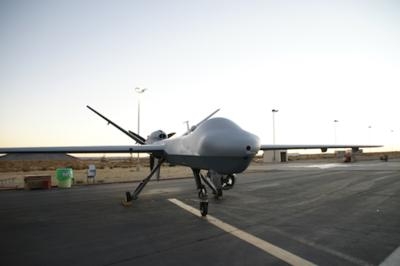Mon, Feb 23, 2015
System Designed To Provide Separation With Other Aircraft
General Atomics Aeronautical Systems, Inc. says it has successfully flight testing its Due Regard Radar, demonstrating the first fully functional air-to-air radar that meets due regard operation requirements.

Due regard operations for remotely piloted aircraft require that the aircraft is outfitted with airborne radar that can provide separation with other aircraft. This technology is key to integrating larger unmanned aircraft systems into the international airspace.
“This flight test is the culmination of over four years of radar development activity,” says Frank Pace, president of Aircraft Systems at GA-ASI. “DRR will allow users to operate Predator B independently in international airspace without the need for land-based, sea-based or off-board airborne airspace surveillance, offering our customers greater freedom of movement around the globe.”
The test was designed to confirm the radar’s onboard functionality and integration with the traffic alert and collision avoidance system II that is used on most commercial aircraft. Collision avoidance maneuvers were automatically and successfully executed to evade planned encounters with small and medium sized manned aircraft. The radar was able to simultaneously track multiple targets while continuing to search a wide field-of-regard, according to a company press release.
“We are honored to be leading the effort to help define standards for flying aircraft such as Predator B in the national airspace system in close cooperation with the FAA, NASA, and our industry partners,” says Executive Vice President of Mission Systems for GA-ASI Claudio Pereida.
Multiple flight tests took place throughout December at Gray Butte Flight Operations Facility and Edwards Air Force Base in Palmdale, California. The DRR is now ready for a customer to conduct an operational test and evaluation in an operational environment.
The integrated sense-and-avoid system including the DRR and TCAS II will continue to fly aboard NASA’s Ikhana unmanned aircraft in 2015 to measure the performance of the entire system in a variety of scenarios.
(Image provided by General Atomics)
More News
He Attempted To Restart The Engine Three Times. On The Third Restart Attempt, He Noticed That Flames Were Coming Out From The Right Wing Near The Fuel Cap Analysis: The pilot repor>[...]
Make Sure You NEVER Miss A New Story From Aero-News Network Do you ever feel like you never see posts from a certain person or page on Facebook or Instagram? Here’s how you c>[...]
From 2009 (YouTube Edition): Leading Air Show Performers Give Their Best Advice for Newcomers On December 6th through December 9th, the Paris Las Vegas Hotel hosted over 1,500 air >[...]
Aero Linx: NASA ASRS ASRS captures confidential reports, analyzes the resulting aviation safety data, and disseminates vital information to the aviation community. The ASRS is an i>[...]
“For our inaugural Pylon Racing Seminar in Roswell, we were thrilled to certify 60 pilots across our six closed-course pylon race classes. Not only did this year’s PRS >[...]
 NTSB Final Report: Rutan Long-EZ
NTSB Final Report: Rutan Long-EZ ANN FAQ: Turn On Post Notifications
ANN FAQ: Turn On Post Notifications Classic Aero-TV: ICAS Perspectives - Advice for New Air Show Performers
Classic Aero-TV: ICAS Perspectives - Advice for New Air Show Performers ANN's Daily Aero-Linx (06.28.25)
ANN's Daily Aero-Linx (06.28.25) Aero-News: Quote of the Day (06.28.25)
Aero-News: Quote of the Day (06.28.25)



